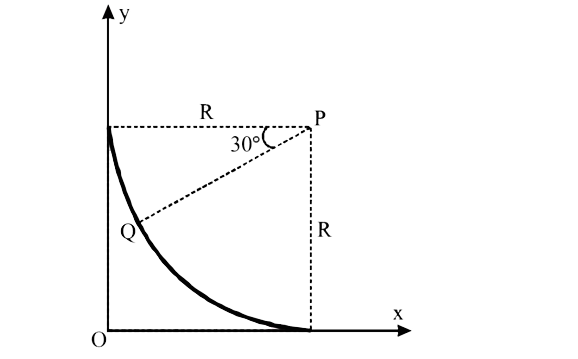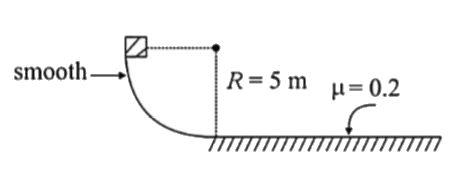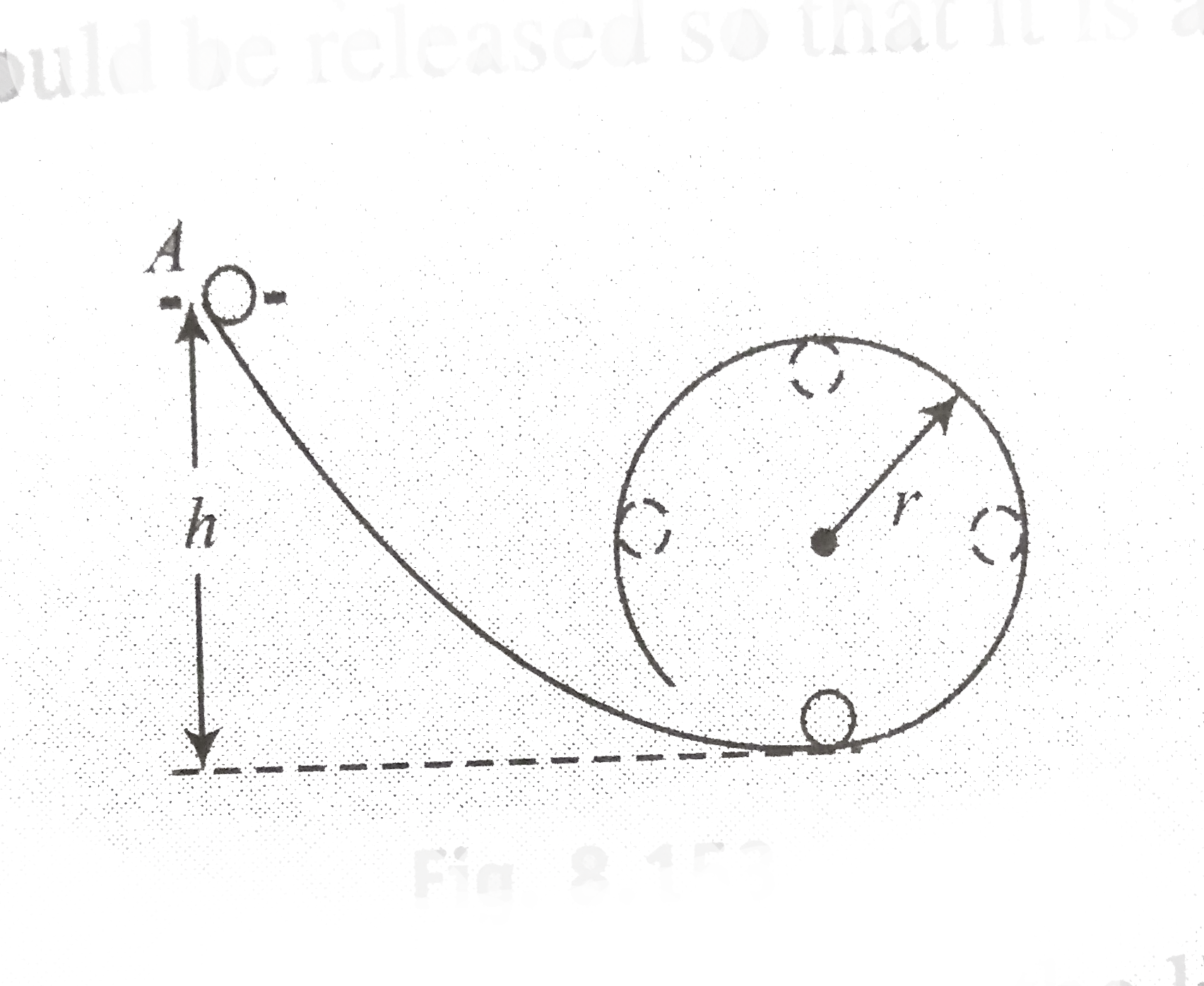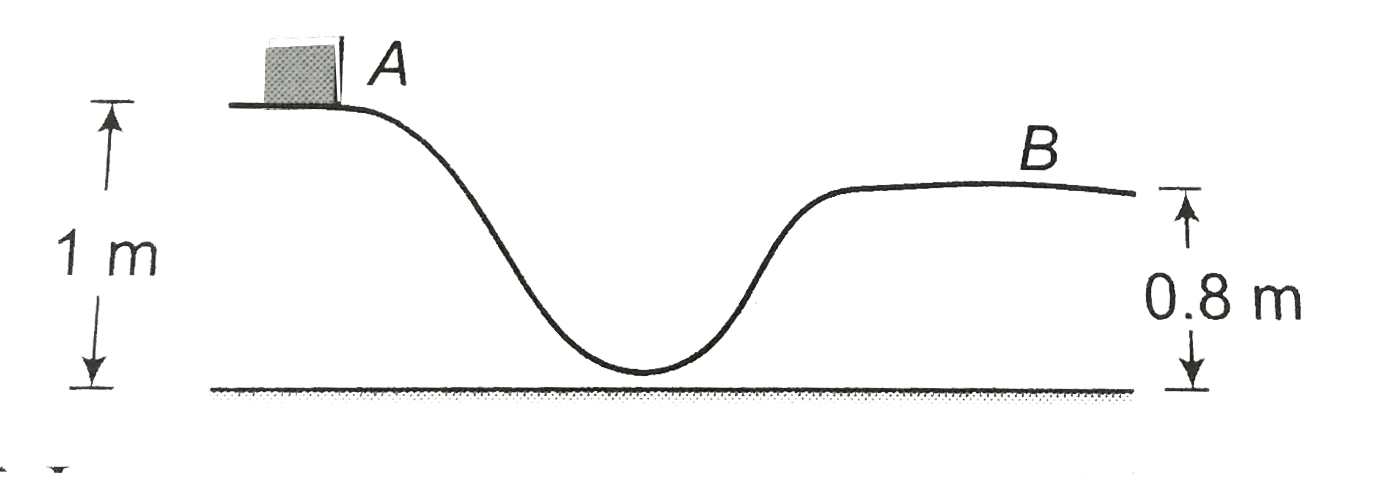A small block of mass 1 kg is released from rest at the top of a rough rtack . The track is a circular arc of radius 40 m. The block slides along the track without toppling and a frictional force acts on it in the direction opposite to the instantaneous velocity . The work done in overcoming the friction up to the point Q , as shown in the figure is 150 J . (Take g=10 m s−2)

The magnitude of the normal reaction that acts on the block at the point Q is .
7.5 N
8.6 N
11.5 N
22.5 N
The correct Answer is:A

Normal reaction acts towards the centre .
N−mgcos60=mv2r
⇒ N=mgcos60∘+mv2r
⇒N−102+1×100040=7.5N
Topper's Solved these Questions
- WORK, ENERGY AND POWER Book:MODERN PUBLICATIONChapter:WORK, ENERGY AND POWER Exercise:Objective Type Questions (Assertion Reason Type Questions)
Explore 13 Videos
- WORK, ENERGY AND POWER Book:MODERN PUBLICATIONChapter:WORK, ENERGY AND POWER Exercise:Objective Type Questions (Matrix Match Type Questions)
Explore 2 Videos
- WORK, ENERGY AND POWER Book:MODERN PUBLICATIONChapter:WORK, ENERGY AND POWER Exercise:Objective Type Questions (C. Multiple Choice Questions)
Explore 16 Videos
- WAVESBook:MODERN PUBLICATIONChapter:WAVESExercise:CHAPTER PRACTICE TEST
Explore 14 Videos
Similar Questions
A small block of mass 1 kg is a circular are of ratius 40 m . The block sides along the track without topping and a frictionnal force acts on it in the direction opposite in the instrmens velocity . The work done in evercoming the friction up to the point Q as shown is the figure below is 150J
(Take the acceleration due to gravity g=10ms−2)

The magnitude of the normal reaction that acts on the block at the point Q is
View SolutionA small block of mass 1 kg is a circular are of ratius 40 m . The block sides along the track without topping and a frictionnal force acts on it in the direction opposite in the instrmens velocity . The work done in evercoming the friction up to the point Q as shown is the figure below is 150J
(Take the acceleration due to gravity g=10ms−2)

The speed of the block when it reaches the point Q is
View Solution
Knowledge Check
A small block of mass 1 kg is a circular are of ratius 40 m . The block sides along the track without topping and a frictionnal force acts on it in the direction opposite in the instrmens velocity . The work done in evercoming the friction up to the point Q as shown is the figure below is 150J
(Take the acceleration due to gravity g=10ms−2)

The magnitude of the normal reaction that acts on the block at the point Q isA7.5NB8.6NC11.5 ND22.5NA small block of mass 1 kg is a circular are of ratius 40 m . The block sides along the track without topping and a frictionnal force acts on it in the direction opposite in the instrmens velocity . The work done in evercoming the friction up to the point Q as shown is the figure below is 150J
(Take the acceleration due to gravity g=10ms−2)

The speed of the block when it reaches the point Q isA5ms−1B10ms−1C10√3ms−1D20ms−1If the block is released. Find the distance traveled by the block on rough track.
 A30mB50mC25mD15m
A30mB50mC25mD15m
A block of mass 4kg is released from the top of a rough inclines plane of height 10m. If velocity of the block is10ms at the bottom of the inclined then work done by the friction force on the block will be
View SolutionA block of mass 4kg is released from the top of a rough inclines plane of height 10m. If velocity of the block is10m/s at the bottom of the inclined then work done by the friction force on the block will be
View SolutionA block is released from rest at the top of an inclined plane which later curves into a circular track of radius r as shown in figure. Find the minimum height h from where it should be released so that it is able to complete the circle.

View Solution
A block of mass 1 kg is placed at the point A of a rough track shown in the figure. If slightly pushed towards right, it stops at the point B of the track. The work done by the frictional force on the block during its transit from A to B is
View SolutionA block is released from rest at the top of an inclined plane which later curves into a circular track of radius r as shown in figure. The minimum height h from where it should be released so that it is able to complete the circle, is
View Solution
